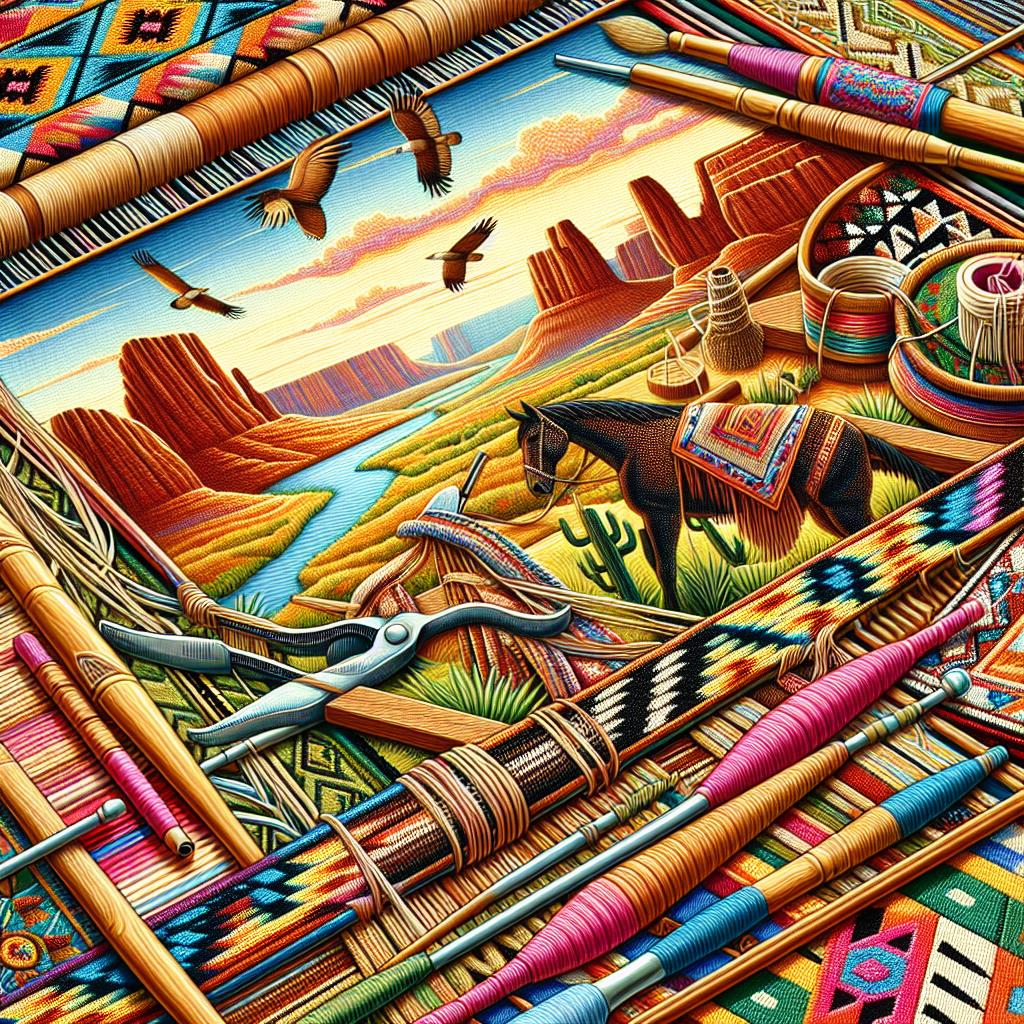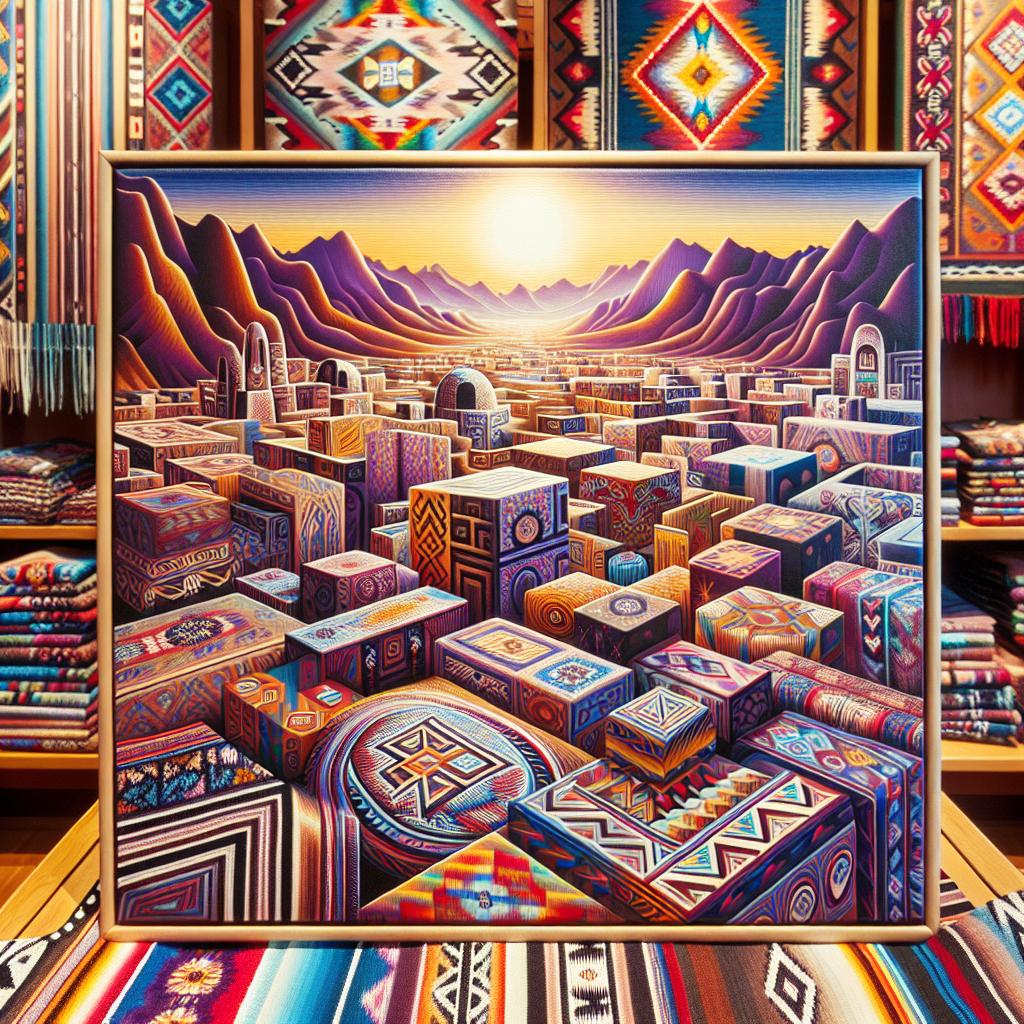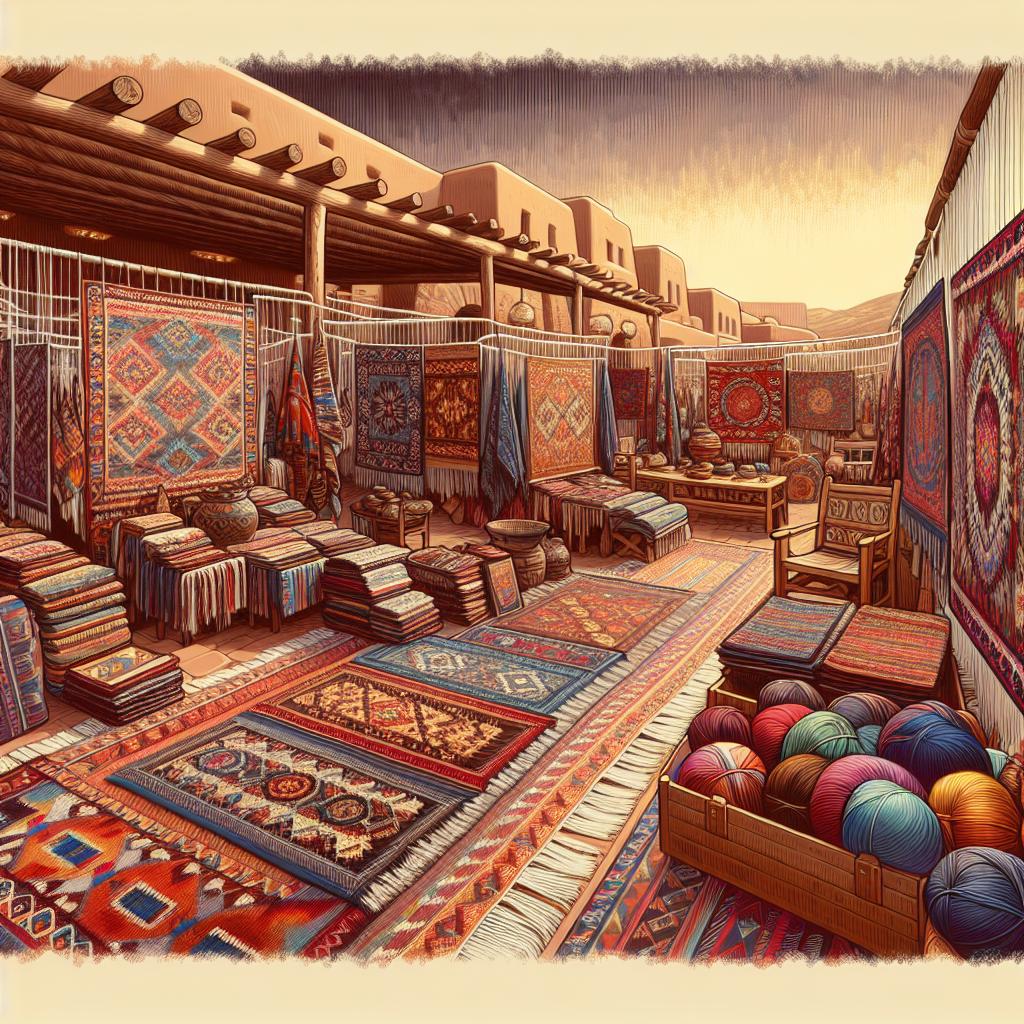The Tradition of Weaving in the Southwest

Historical origins of Southwest weaving
Weaving, an ancient skill that spans across cultures worldwide, has been mastered and passed down through generations. It’s an art and a tradition, much like storytelling or dancing the Macarena at family weddings. One place rich with the history of this craft is the American Southwest region. Now, lend me your ears, or better yet, your eyes, as we take a delightful journey back in time exploring the historical origins of Southwest weaving.
Our colourful tapestry of a tale takes us back thousands of years (that’s right, buckle up for a trip so far backwards Marty McFly would be impressed). Dating back to 1000 BC, the Pueblo people, the indigenous inhabitants of the Southwest, women primarily, honed their weaving skills, transforming them from a means of survival into cherished craftsmanship. Think of it as the evolution of cooking, from charred mammoth steak to Michelin star worthy cuisine.
Archeological findings from their ancient sites show remnants of woven goods, such as sandals, belts, and bags. The Pueblo weavers primarily used cotton sourced from the banks of the Colorado River. Now, I’m not suggesting they were fashion icons designing the first tote bags and statement belts, but the Kardashians might want to take a historical fashion-inspiration trip.
The weaving baton was then picked up by the Navajo, who arrived in the Southwest around the 15th century. Supposedly taught by Spider Woman, a character in Navajo mythology, they adapted the Pueblo weaving practices and soon gave their own twist to the craft. Their looms and technique, a potent cocktail of indigenous culture and tradition, were much more upright than Pueblo styles.
But things got even more interesting when the Spanish colonizers rode into town in the 16th century with their straggly beards, clunky armor, and unnervingly large hats (I swear the fashion choices during this era were truly a sight). They also introduced the famed Churro sheep (no, not the delicious cinnamon treat) to the Navajo. This breed of sheep produced a wool that was free-flowing and fine, perfect for weaving. In due course, wool replaced cotton as the primary material for Southwest weaving.
“He then examines, at great length, the opinions of the ancients from the earliest Greek to the latest Roman critics, on the plan, the diction and poetical merits of the Iliad and the Odyssey; interweaving in this review of ancient criticism his own remarks, which serve either to correct the errors, supply the deficiencies, or illustrate the wisdom of those ancient judges of art”
~ Unknown, Unknown
Who knew fluffy sheep would be the unsung heroes of textile innovation?
The Navajo soon began creating woven goods for trade, ranging from blankets that could keep you toasty in winter to rugs that could tie the room together like a well-placed punchline. They gained recognition for their intricate geometric patterns, distinctive style, and the vibrant dyes they used. Their designs were so mind-blowingly intricate, it could make Picasso question his artistry.
The weaving patterns and styles further evolved when the railroad began whistling its way across the Southwest. A surge of tourists, on a keen hunt for exotic treasures, encouraged weavers to produce goods appealing to these new audiences. The Navajo evolved their designs, incorporating more elements from American and Mexican cultures, thus giving birth to a fantastic blend of tradition and innovation – like when fusion food finally got the recognition it deserved.
Flash forward to the present day, Southwest weaving remains a vibrant and integral part of the regional culture. It’s a direct link to the past, an unbroken thread winding through centuries of tradition, history, and people. It’s evolved from a simple survival skill to a diverse and complex art form, forever spun into the vibrant cultural fabric of the Southwest. From Pueblo cotton weavings to Navajo woollen masterpieces, these patterns tell stories deeper than Ryan Gosling’s eyes, binding generations of people together.
So, there you have it. A brief, quirky, and hopefully amusing trip down the chronicles of Southwest weaving. A rich tapestry of time, culture, resilience, and of course, sheep—always remember the significant contribution of our woolly comrades. Just goes to show, you never know what surprises history might weave up.
Learn More: Historical Origins Of Southwest Weaving

Symbolism in Southwest weaving designs
Title: A Kaleidoscope of Threads: Decoding Symbolism in Southwestern Weaving Designs
Ahoy, dear reader! Fasten your visual seatbelts; we’re about to embark on an electrifying journey, unraveling shimmering threads that weave together a spectacular tapestry – the cherished art of Southwestern weaving. It’s like ‘The Da Vinci Code’, but with an arsenal of yarn instead of secret societies.
Let’s venture into the vibrant realm where the looms click rhythmically, where stories are spun, not spoken, where each twine holds a shimmering secret, and every pattern is a heartfelt poem. This requiem of colors and patterns is more than just a pleasant view; it speaks volumes in the language of the loom, born from the heart of the American Southwest.
First off, let’s talk colors. They’re so much more than just choices to appease picky interior decorators. In Southwest weaving design, there’s a kaleidoscope of hidden meanings dancing in every tint and hue. Black represents darkness, night, things unseen, or your last blind date. Blue, besides echoing the beauty of Southwestern skies and the Instagram addiction we all share, symbolizes the South. White, embodying East, is a nod to the dawn, renewal, and probably that refreshing morning coffee. Yellow, symbolizing West, often alludes to dusk, a closing, or your ever-increasing pile of unfinished work. Finally, red stands for North. It’s both the life force and the radiance of setting suns, almost like that last slice of Serrano ham – vibrant, coveted and hard to let go.
Now, onto the mélange of motifs – the artist’s secret diary. Animal figures are not only a testament to their drawing skills but also hold unique emblematic interpretations.
“The hetman not only refuses to grant you permission by letter to cover your mad designs with his dignity, but he commands you sternly, and under pain of losing his favor, to drop them at once”
~ Henryk Sienkiewicz, Pan Michael: an historical novel of Poland, the Ukraine, and Turkey
The hummingbird doesn’t just symbolize manic energy and an enviable metabolism, but also safe, speedy journeying. The butterfly, apart from being an inspiration for ardent bodybuilders, signifies transformation and rejuvenation. And the turtle isn’t just a sassy reptile with a mobile home; it embodies earth, perseverance, longevity, or that grand ‘slow and steady’ mantra we love to ignore.
Next comes a crowd favorite – the geometric patterns, which aren’t just there to discriminate against the symmetry-challenged among us. Spirals often symbolize life cycles, growth, and enlightenment – practically an Alice in Wonderland rabbit hole in woven form. Diamonds could stand for the stars, the universe, and cosmic awareness- basically, the stuff Neil deGrasse Tyson dreams about, while zigzags might represent lighting, life energy, or simply that roller coaster called life, with its unpredictable ups and downs.
Lastly, we must make a nod towards the omnipresent ‘eye’ motifs among Southwest designs. No, it’s not a tribute to Big Brother, but it typically signifies spiritual protection, wisdom, and knowledge. It’s like a woven amulet that’s not only pretty but also has your back.
So, the next time you glare at a piece of Southwestern weaving, hold off on your color judgement and try imitating Sherlock Holmes instead. Because there’s a whole universe of enigmatic tales hidden in those knots, threads, and colors. Like underappreciated secret agents, they slyly carry forward the spiritual insights and traditional knowledge of the weaver, covertly whispering the vivid stories of glorious Southwestern landscapes, ancient cultures, and resilient hard-working people. Time to give those Southwestern woven pieces the attention they deserve!
Learn More Here: Symbolism In Southwest Weaving Designs

Modern influence and preservation of Southwest weaving traditions
Title: Looming Legacy: A Zesty Zap into Southwestern Weaving Traditions
Introduction
Ladies and gents, buckle on your metaphoric cowboy boots. We’re saddling up for a spunky, color-splashed journey into the heartbeat of the Southwest. We’ll flip through the vibrant pages of Southwestern weaving traditions where the musty smell of sheep wool intermingling with a rainbow of dye sweeps you off your feet. However, this is not a psychedelic sixties flashback—we’re talking about the sensational weaving traditions of the Southwest. So, grab your loom, your bandana—you’re about to experience a vibrant blast from the past!
Once Upon a Time in the Wild, Wild Southwest
Imagine: Barbary sheep grazing under a burning sienna sunset, Puebloan cultures flourishing along jagged cliffs, and weavers carding, spinning, and dyeing wool with natural dyes from cochineal bugs (trust me, they’re harmless). If you’re seeing this vision in sepia, you have almost got the scene right. Just be sure to adjust your color settings—olden day Southwestern weaving traditions were as colorful as a desert in bloom.
Southwestern weaving traditions are deeply rooted in Navajo, Puebloan, Hopi, and other indigenous communities. These traditions are far more than just a practical means of producing blankets, rugs, and clothing—it’s a distinct language that tells color-soaked sagas of gods, ancestors, and heroism, unfolding across vividly patterned textiles. The weavings are a tangible link between today’s residents and their ancestors, connecting the past and the present, more powerfully than the sturdiest loom.
Modern Influence on Weaving Traditions of the Southwest
Fast forward a few centuries. The modern global community, much like a child in a candy shop, found these traditional textiles irresistible.
“So it was in this city of these remarkable traditions, linked with ancient history and seemingly with no connection to the modern world, that the _France_, flying the ensign of the Chicago _Daily News_, let go her anchor, to the astonishment of the natives, who, no doubt, knew more of the illustrious Mithradates and his doings than of the city of Chicago, which, in the form of the _France_, had so unexpectedly descended on their legend laden harbor”
~ Stanley Washburn, The Cable Game
As a result, we witnessed a delicate dance between global influences and preservation. Southwest weaving faced an influx of synthetic dyes, commercial wool, and mechanized looms, while grappling with the demands of a global market hungry for indigenous art. Insurance executives and software engineers suddenly craved a piece of the Southwestern ‘exotic’ for their concrete cubicles.
But it’s not all commercialization and Capuccinos. Many modern artists—some descendants of the original weavers—have embraced these innovations while preserving the essence of the craft. They have stitched together tradition and modernity, merging age-old designs with fresh visual narratives. The result? An avant-garde revival that makes Southwestern textiles both a slice of history and a contemporary art form.
Keep Calm and Weave On: How Tradition Survives Today
Despite the modern adaptations, the song of the old loom still resonates in the quiet corners of the Southwest. Artisans utilize the same loom setups, techniques, and rituals as their ancestors. They continue to dye their threads with plants, insects, minerals, and imagine—no two-day shipping needed! This is an artisanal time-capsule; so if you hear a soft hum in the distance, it might just be an ancient yarn whispering its age-old secrets!
Drawing youngsters into the traditional weaving web, many Southwest communities have set up local initiatives and training programs. Strip away the Instagram filters, and here you will find the real ‘loominati’—the digging, spinning, and dyeing masters, preserving the ecological, economic, and cultural sustainability of their tribal communities.
Conclusion
So, friends, as the scorching sun sets across the arid Southwest, casting long shadows over the rugged landscapes, the threads of tradition continue to intermingle and weave tales into the modern tapestry. It is a testament to the resilience of a craft that transcends time, a testament to the survival of Southwestern weaving traditions in a world that often forgets to slow down and appreciate the simple wonders of our heritage.
Keep weaving on, Southwest, you’ve got the whole world wrapped around your colorful, cultural spool!
Yee-haw!
Like This? Try: Modern Influence And Preservation Of Southwest Weaving Traditions
